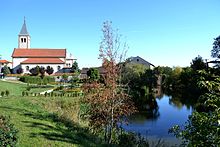Vlčkovce
| Vlčkovce | ||
|---|---|---|
| coat of arms | map | |

|
|
|
| Basic data | ||
| State : | Slovakia | |
| Kraj : | Trnavský kraj | |
| Okres : | Trnava | |
| Region : | Dolné Považie | |
| Area : | 12,163 km² | |
| Residents : | 1,385 (Dec. 31, 2019) | |
| Population density : | 114 inhabitants per km² | |
| Height : | 132 m nm | |
| Postal code : | 919 23 | |
| Telephone code : | 0 33 | |
| Geographic location : | 48 ° 18 ' N , 17 ° 39' E | |
| License plate : | TT | |
| Kód obce : | 556513 | |
| structure | ||
| Community type : | local community | |
| Administration (as of November 2018) | ||
| Mayor : | Ivan Dobrovodský | |
| Address: | Obecný úrad Vlčkovce č. 15 919 23 Vlčkovce |
|
| Website: | www.vlckovce.sk | |
| Statistics information on statistics.sk | ||
Vlčkovce (until 1948 Slovak "Farkašín"; German Farkaschin or Wolf Bruck , Hungarian Farkashida ) is a municipality in the west of Slovakia with a population of 1,385 (December 31, 2019). It belongs to the Okres Trnava , a lower part of the Trnavský kraj .
geography
The community is located in the Danube hill country (part of the Slovak Danube lowlands ) on Dudváh . The center of the village is at an altitude of 132 m nm and is eight kilometers from Sere neun and nine kilometers from Trnava .
history
Vlčkovce was mentioned in writing for the first time in 1336 and was located on the “Bohemian Road”, which crossed the Dudváh river here, so it was a rest stop and later a toll station. The place belonged to the estate of Schintau , after 1817 of Lanschütz . In the 16th century the Habans came to Farkashin. In 1828 the place had 552 inhabitants. 1925–1971 there was a sugar factory in town. In 1948 the place name was changed to the Slavic form (vlk (Slovak) = farkas (Hungarian) = "wolf") for national political reasons.
1975-1990 Vlčkovce was together with neighboring towns Križovany nad Dudváhom and Opoj a part of the municipality Dudváh.
population
Results of the 2001 census (1149 inhabitants):
|
By ethnicity:
|
By denomination:
|
Attractions
- Roman Catholic Church of St. Theresa from 1934
- Buildings of the sugar factory and the Habanian mill

